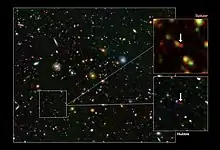| GN-108036 | |
|---|---|
 | |
| Observation data (J2000 epoch) | |
| Constellation | Ursa Major |
| Right ascension | 12h 36m 22.68s |
| Declination | +62° 08′ 07.5″ |
| Redshift | 7.2 |
| Heliocentric radial velocity | 2,162,403 km/s |
| Distance | 12.9 billion ly (4.0 billion pc) (light travel distance) 29 billion ly (8.9 billion pc) (present proper distance) |
| Characteristics | |
| Type | Irregular |
| Size | 5,000 ly (diameter) |
| Apparent size (V) | 0.0013 x 0.0013 |
| Other designations | |
| OOM2012 GN 108036, FRP2015 z7 GNW 4703 | |
GN-108036 is a distant galaxy discovered and confirmed by the Subaru Telescope and the Keck Observatory located in Hawaii; its study was also completed by the Hubble Space Telescope and the Spitzer Space Telescope.[1]
The redshift was z = 7.2, meaning the light of the galaxy took nearly 13 billion years to reach Earth and therefore its formation dates back to 750 million years after the Big Bang . It has a high rate of star formation, at a rate of 100 solar masses per year, or about 30 times more than the Milky Way that is 5 times larger and 100 times more massive.
See also
References
- ↑ "NASA Telescopes Help Find Rare Galaxy at Dawn of Time" NASA. Retrieved 2015-09-22.
This article is issued from Wikipedia. The text is licensed under Creative Commons - Attribution - Sharealike. Additional terms may apply for the media files.